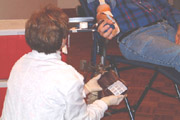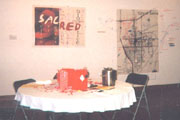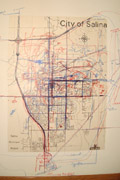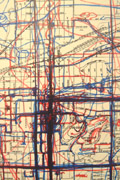
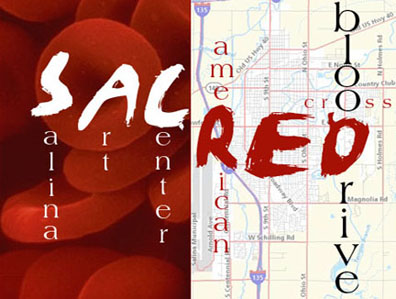
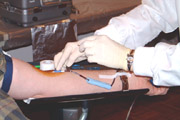 |
|
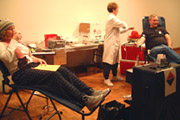 |
|
SACred: Art-Bloodrive
SACred art-bloodrive
consisted of two main components: a blood drive which was held on March
2, 2002 at the Salina Art Center in Salina, Kansas; and an interactive,
demographic investigation of S.A.C. visitors and blood donors. The art-bloodrive
differed from a typical blood drive in that it was conceived as a social
experiment aimed at facilitating the cooperative sharing of resources
between two different community groups: the Salina Art Center and the
American Red Cross. The objectives and desires of the organizations were
similar in both poetic and literal respects. Both groups felt they provided
an invaluable community service; both groups sought to increase circulation
and enrichment through community programs; both groups wanted to increase
their number of donors. By organizing a collaboration between the two
organizations, SACred hoped to meet common goals while presenting the
possibility of responsible citizenship through creative action. The Red
Cross was given the physical and logistical support to collect blood donations;
the Salina Art Center gained demographic information on its visitors while
expanding its capacity to serve the community - beyond gallery walls -
in material as well as symbolic ways. As the host institution, it was
the Art Center's responsibility to provide food and beverages for the
blood donors, so the Center's staff was given full creative license to
interpret this role. Consequently, staff members rose to the occasion
and assisted in the creation of that portion of the installation/experience
by providing a decorative table display replete with goodie-bags, home-baked
treats, and fresh chili.
Although
the blood drive was a one-day event, the demographic investigation lasted
for the 3-month duration of the exhibition. In addition to the donor sign-up
sheets and the blood drive questionnaire, visitors participated in a mapping
project. On an eight foot city map transferred on to the gallery wall
visitors were encouraged to use a blue marker labeled "depleted"
and a red marker labeled "enriched" to draw the routes taken
to and from the Art Center. As a result, circulation patterns were generated
which placed the Art Center as the heart of the community (or as a blood-sucking
leach, depending on the order in which one used the markers). By allowing
the visitors to map the veins and arteries of the social body, the range
of the Art Center's community outreach was illustrated as the areas most
"enriched" and most "depleted" became apparent. The
map also gave visitors the unique experience of being asked to draw on
institutional walls/art in a process which created an artwork that served
both as an indictment of class relations and as an opportunity to pursue
greater communal involvement. Throughout the exhibition's duration, many
out-of-town visitors seized on the graffiti invitation and extended their
routes far beyond the map's boundaries to approximate their point of origin.
The questionnaire
sought additional information ranging from basic demographic data (age,
gender, ethnicity, occupation, income, and blood type) to logistical and
philosophical queries such as: "Why did you choose to give blood?
In your opinion, what is the 'lifeblood' of the community? How can the
Art Center improve its circulation throughout the community? Would you
agree to allow the Art Center to use a portion of your blood donation
for future art-related experiments/projects?" Participants were also
asked to indicate which projects they would be willing to support by circling
choices from a list which included, among others: immunology, cloning,
market research, homeland security, product testing, and painting. While
some questions were aimed at acquiring constructive feedback from visitors,
others took a Socratic approach in an attempt to raise further questions
regarding art, community, and creative problem-solving in the information
age.
